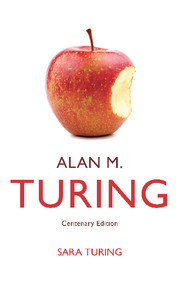Book contents
14 - Computing Machinery
Published online by Cambridge University Press: 05 April 2012
Summary
The World of Mathematics, referred to in Part I, contains an article entitled “The General and Logical Theory of Automata” by John von Neumann which gives the ensuing synopsis (vol. 4, pp. 2093–2095) of Alan's Theory of Computing Automata:
The English logician, Turing, about twelve years ago attacked the following problem. He wanted to give a general definition of what is meant by a computing automaton. The formal definition came out as follows:
An automaton is a ‘black box’ which will not be described in detail but is expected to have the following attributes. It possesses a finite number of states, which need to be prima facie characterised only by stating their number, say n, and by enumerating them accordingly: 1, 2, …, n. The essential operating characteristic of the automaton consists of describing how it is caused to change its state, that is, to go over from a state i into a state j. This change requires some interaction with the outside world, which will be standardized in the following manner. As far as the machine is concerned, let the whole outside world consist of a long paper tape. Let this tape be, say, one inch wide, and let it be sub-divided into fields (squares) one inch long. On each field of this strip we may, or may not, put a sign, say, a dot, and it is assumed that it is possible to erase as well as to write in such a dot. […]
- Type
- Chapter
- Information
- Alan M. TuringCentenary Edition, pp. 125 - 132Publisher: Cambridge University PressPrint publication year: 2012



